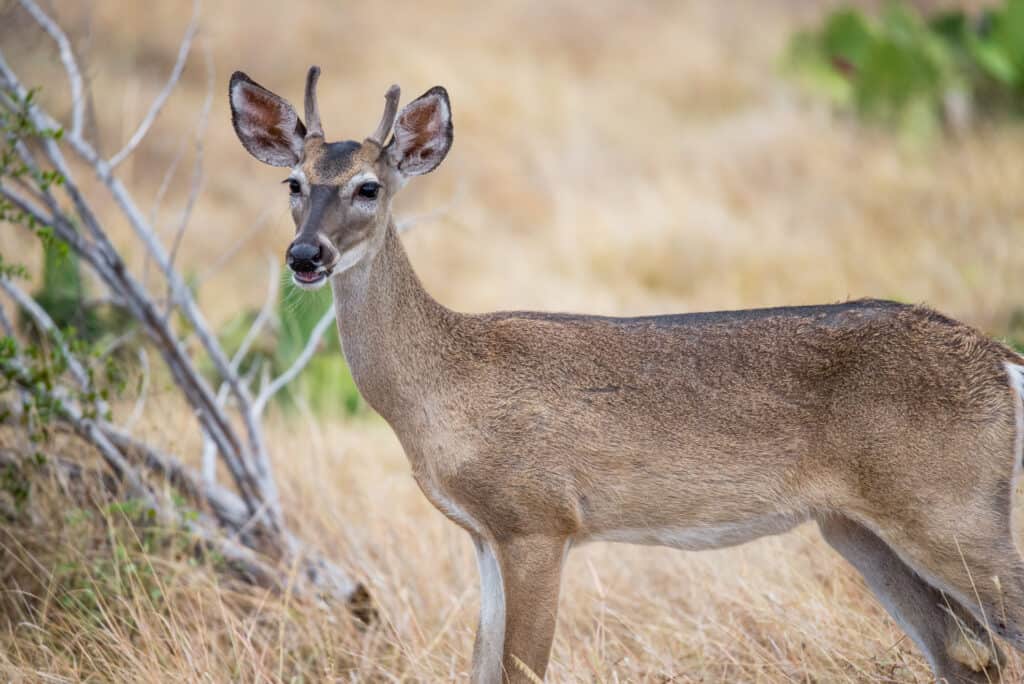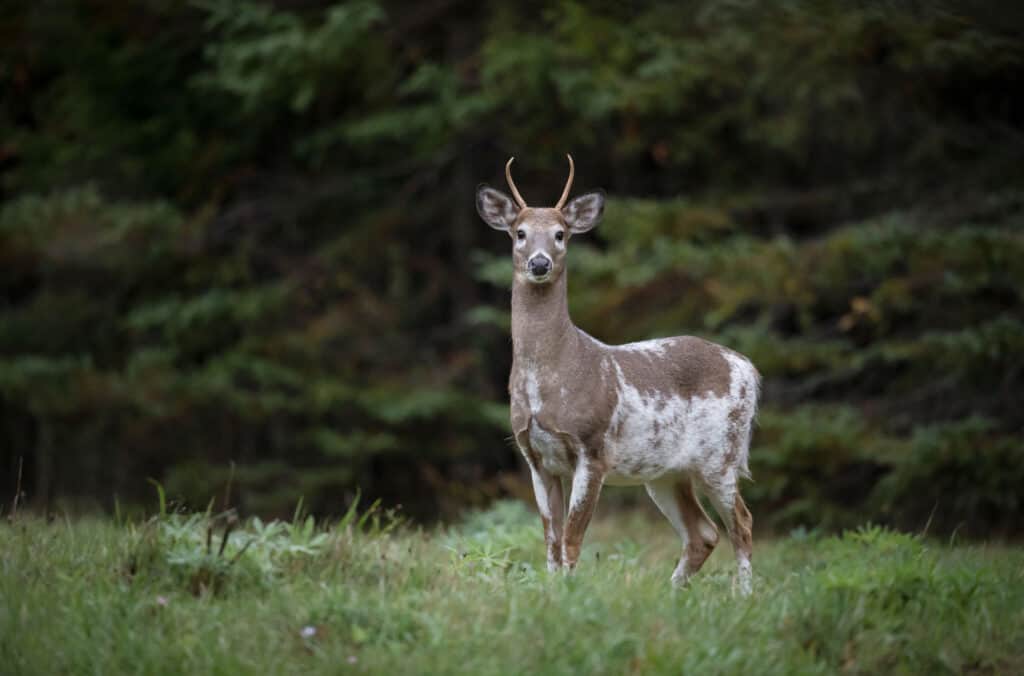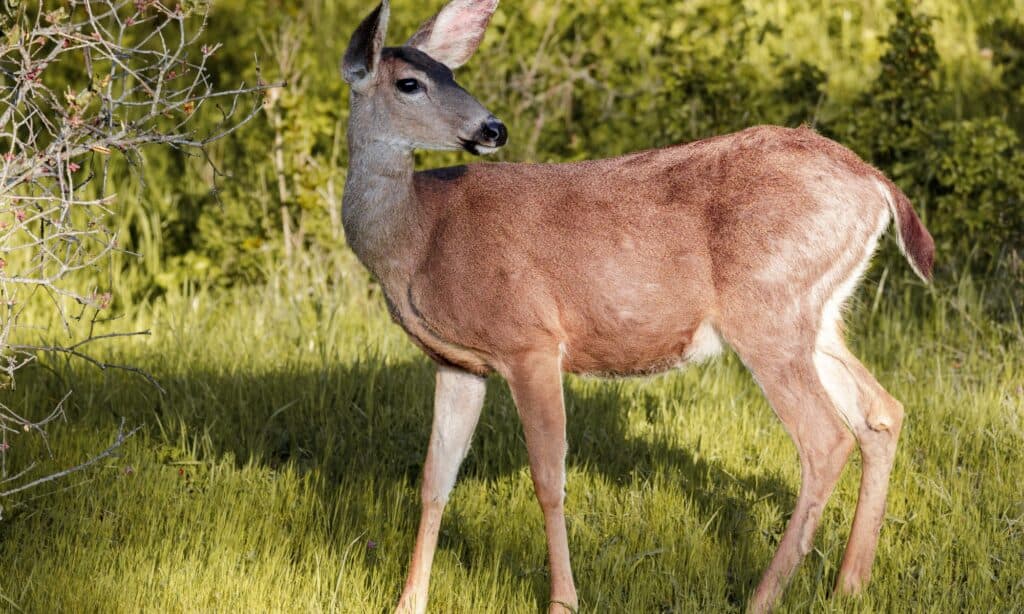In North Carolina, deer season is open in the fall and winter, from early September until early January. The North Carolina Wildlife Resources Commission (NCWRC) manages the wildlife population in the state and determines all hunting seasons. This is done by setting the types and lengths of the deer seasons and the bag limits for bucks and does. The main method used to control the overall deer population is changing the bag limits for antlerless deer in various areas.
The state is divided into five deer zones with different season dates and bag limits. The seasons are generally open in each zone around the same time, but opening dates can vary by four weeks or more for some seasons. The NCWRC also sets and enforces wildlife regulations, which every hunter must follow.
The rules can be a bit complicated, so let’s look at all the requirements and regulations.
Hunting License and Permit Requirements

Hunting deer in North Carolina requires a license.
©iStock.com/GizmoPhoto
To hunt in North Carolina, hunters over the age of 16 must purchase a North Carolina hunting license.
Youths under the age of 16 are exempt from purchasing a hunting license. However, they must obtain a License-Exempt Big Game Harvest Report Card to hunt deer. Anyone over the age of 16 that are resident of North Carolina must purchase a Resident State Hunting License, a Resident Combination Hunting/Fishing License, a Resident Comprehensive Hunting License, or a Resident Sportsman License.
The Hunting license is the minimum and lowest cost option, the Combination license includes fishing privileges, and the Comprehensive license includes additional hunting privileges. A Sportsman license is the top-tier license for the avid outdoorsman and includes additional hunting and fishing privileges. A Resident Lifetime Sportsman license that includes all the privileges of the Sportsman license and is valid for the life of the hunter is also available. This license costs significantly less for children and is a popular option for avid hunters to purchase for their children.
Hunters over the age of 16 that do not live in North Carolina and would like to visit the state to hunt must purchase a North Carolina nonresident license. A short-term Nonresident State Hunting 10-Day License is available for ten days from purchase. A Nonresident State Hunting License valid for one year is also available. This available option includes the same privileges as the Resident version.
Big Game Hunting License
Hunters who purchase the Base Hunting License must also purchase a Big Game Hunting License. Residents must purchase the Resident Big Game Hunting License; Nonresidents must purchase either the Big Game Hunting 10-day License or the annual version.
Hunters that have a Comprehensive or Sportsman license do not need to purchase the Big Game hunting license as it is included with these licenses. In addition to the regular licenses, a Bonus Antlerless Deer License allows hunters to harvest two additional antlerless deer in any area included in the Urban Archery Season.
Hunter Education in North Carolina
To purchase a license, hunters must present proof that they have successfully completed a hunter education course. The only exception to this requirement is for hunters with a North Carolina Hunting Heritage Apprentice Permit or a North Carolina hunting license valid before July 1, 2013.
The Hunting Heritage Apprentice Permit is for hunters who want to try hunting but have not taken a hunter education course. Hunters with this permit may hunt but must be accompanied by an adult that is 18 years old or older. The accompanying adult must stay close to the apprentice hunter so they can monitor their activity at all times.
The hunter education course is available in all counties in North Carolina in an in-person classroom setting. There are also virtual classes and online courses available.
Deer Seasons in North Carolina

There are three basic deer season types in North Carolina.
©iStock.com/Brittany Crossman
North Carolina has three basic deer season types, archery, black powder, and gun. There are restrictions on the equipment that can be used during each season.
The dates these seasons open vary between the Western, Northwestern, Central, Northeastern, and Southeastern zones. Archery season opens in all zones on the second Saturday of September but closes on various dates between late September and early November.
The Blackpowder season typically opens just after Archery season closes in each zone around two weeks later.
Gun season follows and stays open until Jan 2nd in all but the Western zone.
The three seasons usually do not overlap, so it is important to know what season and zone you would like to hunt and plan ahead. These seasons have certain times when antlerless deer can be harvested that may not be the same as the full season. The either-sex seasons should also be reviewed if you plan to harvest an antlerless deer. There is also a Youth Deer Hunting day held on the fourth Saturday of September and an Urban Archery Season open the second Saturday in January through the third Sunday in February.
Season Regulations and Approved Weapons
The three deer seasons have various regulations on the equipment that may be used. This list summarizes every legal weapon that is allowed.
Archery Season
Archery equipment is allowed during this season and is defined as any handheld device with a rigid stationary handle with two limbs and a string. The device must use a non-pneumatic means to propel one arrow or bolt at a time.
Longbows, recurve bows, compound bows, and crossbows are examples of bows that are allowed. Longbows and recurve bows must have a draw weight of at least 40 pounds. Compound bows must have a draw weight of at least 35 pounds, and crossbows must have a draw weight of at least 100 pounds.
Arrows and bolts must have broad or mechanical opening broadheads with a minimum width of 7/8 of an inch in the open position. Sling bows are also allowed and must have a minimum draw weight of 40 pounds. No firearms are allowed during this season.
Black Powder Season
Black powder firearms are allowed during this season. Shotguns, rifles, and handguns may have their firing components loaded from the muzzle, cylinder, or breech and cannot use fixed ammunition. These firearms must be manufactured before 1898 or replicas with matchlock, flintlock, percussion cap, or similar ignition systems.
Replicas must be designed not to allow modern rimfire or centerfire ammunition to be used. Black powder or a black powder substitute must be used. Archery equipment may be used during this season.
Gun Season
Modern firearms that fire cartridges, such as rifles, handguns, and shotguns, may be used during the gun season. Rifles may not be capable of fully automatic fire. Some counties prohibit the use or restrict what rifles can be used in local areas.
For handguns, there are no restrictions on caliber or barrel length. Shotguns must be ten gauges or smaller. Both archery equipment and black powder firearms may be used during this season.
Youth Deer Hunting Day
This day is open to only youths under the age of 18. Any legal weapon described in the archery, black powder and gun season above may be used. Hunters over the age of 18 may hunt on this day but must use a weapon that is allowed for one of the regular seasons that is open on this day.
Urban Archery Season
During this season, only archery equipment is allowed. This season is for cities and towns to reduce urban deer populations if they elect to do so. Not all areas may choose to have this season; check each season.
Other General Regulations

Safety is important in deer hunting.
©iStock.com/yhelfman
North Carolina has a few key rules and regulations that deer hunters must be aware of. While the list of regulations is pretty long, some are more prominent than others. Here’s a list of the most important regulations to consider.
Deer may be taken ½ hour before sunrise to ½ hour after sunset. On Sunday, hunting with a firearm between 9:30 am to 12:30 pm is not allowed except on controlled hunting preserves.
Hunting within 500 yards of a place of worship with a firearm is not allowed. Hunters may use one dog on a leash and a portable light to locate a wounded or downed deer. Using dogs to assist with hunting deer is not allowed in certain counties.
Archery hunters may dispatch a wounded deer with a .22 caliber rimfire pistol.
Hunting from a vehicle, boat, or aircraft is not allowed. Some counties allow hunting deer from boats or other vessels.
Anyone hunting during a season when firearms are allowed must wear a hat or cap or an outer garment made from hunter orange. Hunter orange must be visible from all sides.
Using artificial lights or electronic calls while deer hunting is not allowed. Hunting or shooting from a public road or right-of-way is not allowed in some counties due to local law.
Taking deer that are swimming or standing in water that is above their knees is not allowed.
Hunters must have permission from the landowner to hunt on private land. Antlered deer are any deer with visible bony structures that protrude through the skin. The season bag limit is six deer; only two of these may be antlered. Note that deer harvested with a Bonus Antlerless Deer license do not count towards the season limit.
Safety is important in deer hunting since firearms and other deadly weapons are involved. Hunters should understand and follow all firearm safety rules when handling a firearm. Bowhunters should also be safe with their arrows by keeping the broadheads safely covered until ready to shoot.
Before taking a shot, be sure to identify your target deer clearly. It is critical to make sure it is a deer and to make sure it is antlered or antlerless. Also, make sure to review what is beyond your target deer. If you miss your shot, could you hit another deer, or is there an area where other people may be? Hunters are responsible for every shot they take and any damage that it may cause.
Hunting from an elevated position is popular among deer hunters since deer do not have natural predators from above. It also usually allows deer to approach closer to hunters, which is helpful to bowhunters. If you choose to use a tree stand, it is important to know that more hunting injuries occur from falling while using a tree stand than any other type of hunting accident.
Before hunting from a tree stand, be sure to understand how to climb and use it safely at ground level. Use a full-body safety harness and a lifeline whenever your feet are not on the ground. Since most falls tend to occur while hunters are climbing into or out of the stand, do not carry your equipment while you are climbing. Weapons should be unloaded and pulled up with a haul line after you are safely in the stand. Choose a healthy tree for your stand, and do not rely on small or dead branches to support your weight.
Chronic Wasting Disease Concerns in North Carolina
Chronic Wasting Disease (CWD) is a neurological disease that affects deer and other cervids such as elk and moose. The disease is contagious and always fatal. A mutated protein causes the disease called a prion and causes legions in a deer’s brain. Deer infected can appear confused, have excessive body weight loss, and may not act normally.
No tests exist that can detect CWD in deer while they are alive, and there is no known treatment or cure. The disease is spread by an infected deer shedding prions in its saliva, urine, and feces. Transmission is thought to mainly occur through direct contact, but deer can also become infected by contacting the prions in the soil. Prions are very resistant to the environment and can remain in the soil for an extended period of time.
Once it is detected in an area, it is important not to allow it to spread further since it is impossible to eliminate once it is in the soil.
CWD has been found in multiple US states and Canada. On March 31, 2002, the first confirmed case of CWD was detected in a hunter-harvested buck in Yadkin County, North Carolina. A few days later, the NCWRC established a Primary Surveillance Area (PSA) and a Secondary Surveillance Area (SSA). In the PSA, hunters must submit a sample for CWD testing during the entire black powder season and the entire gun season.
In the SSA, hunters must submit samples during the black powder season and the first nine days of gun season.
On top of the required testing, there are deer carcass transportation restrictions. Any deer that is harvested in the PSA or SSA may not be transported outside of the area unless it meets certain requirements.
Meat must be boned out and have no pieces or fragments of bone remaining. Hides must have no part of the head or spinal column attached. Antlers and antlers attached to skull plates must be clean with no tissue attached. Lower jawbones with teeth must be clean with no tissue. Taxidermy mounts are allowed and must be completed.
Feeding wildlife in the PSA and SSA is also restricted. Bait or other types of food, mineral, and salt licks for deer are not allowed from Jan 2 – Aug 31 in the PSA and SSA. The NCWRC may have some exceptions to this rule for specific activities.
There has been no evidence of CWD affecting humans. However, the CDC recommends that hunters take precautions and not consume meat from animals that appear sick or test positive for CWD. Minimize handling deer carcasses and always wear gloves when field dressing and butchering your harvested deer.
After Harvesting a Deer
All hunters should carry their Big Game hunting license with them while hunting. The license has a Big Game Harvest Report card attached to it.
Once a deer is harvested, and before it is moved from the kill site, the hunter must punch or cut the date and month the harvest occurred on the harvest report card. Once the harvest has been validated, the deer may be field dressed and transported.
Before the deer is processed or left in someone else’s possession, the harvest must be registered with the NCWRC. Registration must also occur before noon on the day following the harvest. The harvest registration can be done in one of three ways. The first is by phone by calling 800-I-GOT-ONE. The second is online by visiting the Reporting page on the NCWRC website here. The third is by visiting a participating wildlife service agent location.
Potential Fines and Punishments
If a hunter takes a deer illegally in North Carolina, fines will likely follow. However, hunting privileges can also be taken away, and some hunters may even face jail time. The hunting equipment used to harvest the deer could also be confiscated.
The NCWRC has a Turn-In-Poacher (TIP) program, which offers a reward of $100 to $1000 for any information on hunters taking deer illegally. In 2016, three adults and two juveniles were charged with multiple cases of taking deer illegally. These violations were misdemeanors, which could result in each facing a fine of $500 and about $15,000 in restitution for the deer that were taken illegally.
Of course, lawyer fees and court costs must also be paid for individuals who find themselves in court.
The hunting regulations are laws in North Carolina, so any violations can result in stiff penalties. Some may feel that wildlife laws are not important, but the law is the law, and a violation is a serious offense. Before hunting for the first time each season, hunters should review and be up to date on all the regulations.
The photo featured at the top of this post is © Tomasz Wrzesien/Shutterstock.com
Thank you for reading! Have some feedback for us? Contact the AZ Animals editorial team.







